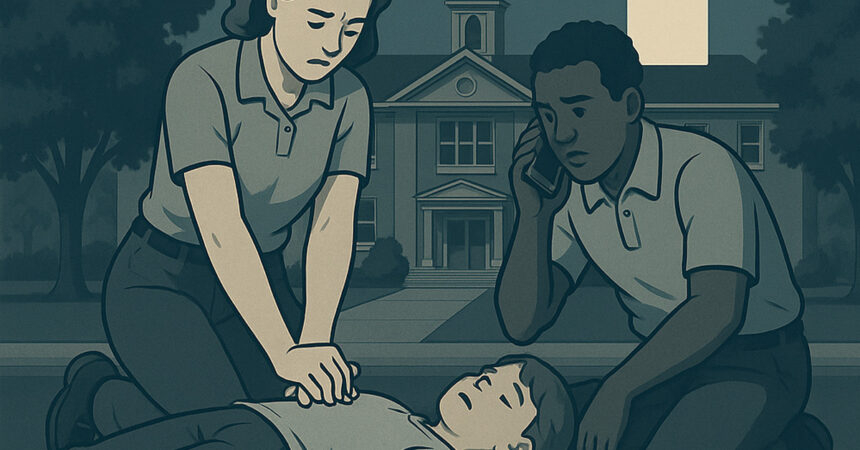school cardiac arrest : A devastating incident has shaken the educational community in Rajasthan. Nine-year-old Prachi Kumawat collapsed while opening her lunch box at school. The tragedy occurred during what should have been a normal lunch break. Instead, it became a nightmare that highlights serious concerns about child health.
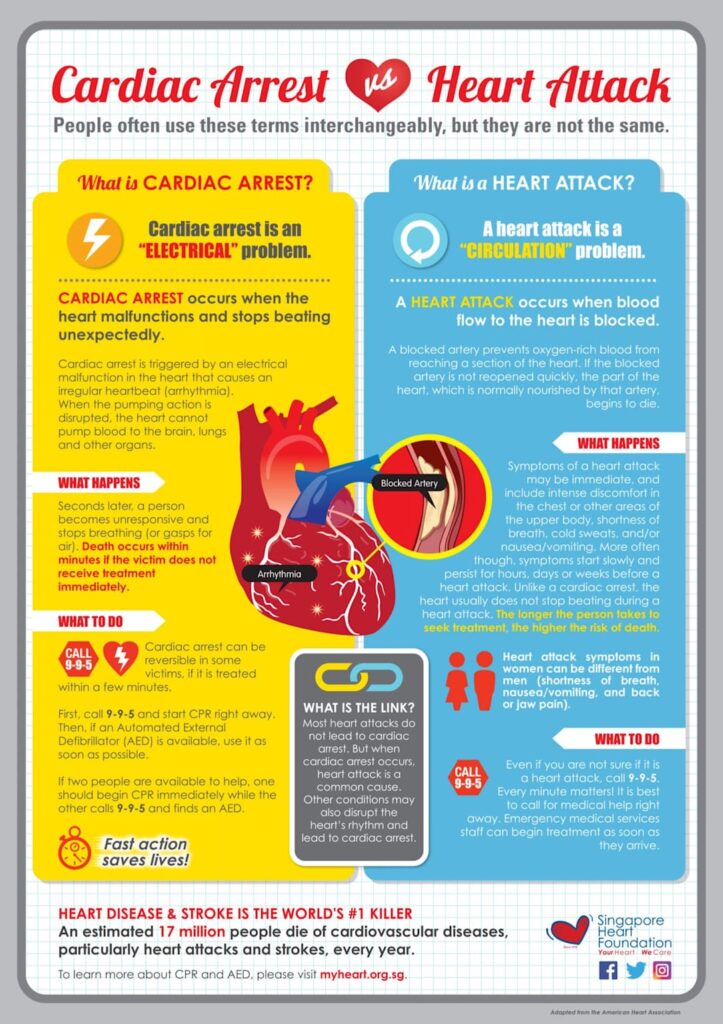
The Heartbreaking Incident
On Tuesday morning around 11 AM, Prachi attended Adarsh Vidya Mandir School in Danta, Sikar. She participated in the morning assembly with her usual bright smile. However, during lunch break, something went terribly wrong. The Class 4 student was opening her tiffin box when she suddenly collapsed.
Principal Nand Kishore described the shocking moment. “She dropped her lunchbox and collapsed,” he explained. The food scattered across the classroom floor as panic spread among students. Teachers immediately rushed to help the unconscious child.
Meanwhile, her classmates began screaming in fear. The school staff quickly realized this was not an ordinary fainting episode. Children sometimes faint at school, but Prachi’s condition seemed different.
Read More: BluSmart Cab Disaster: From Trust to Fraud
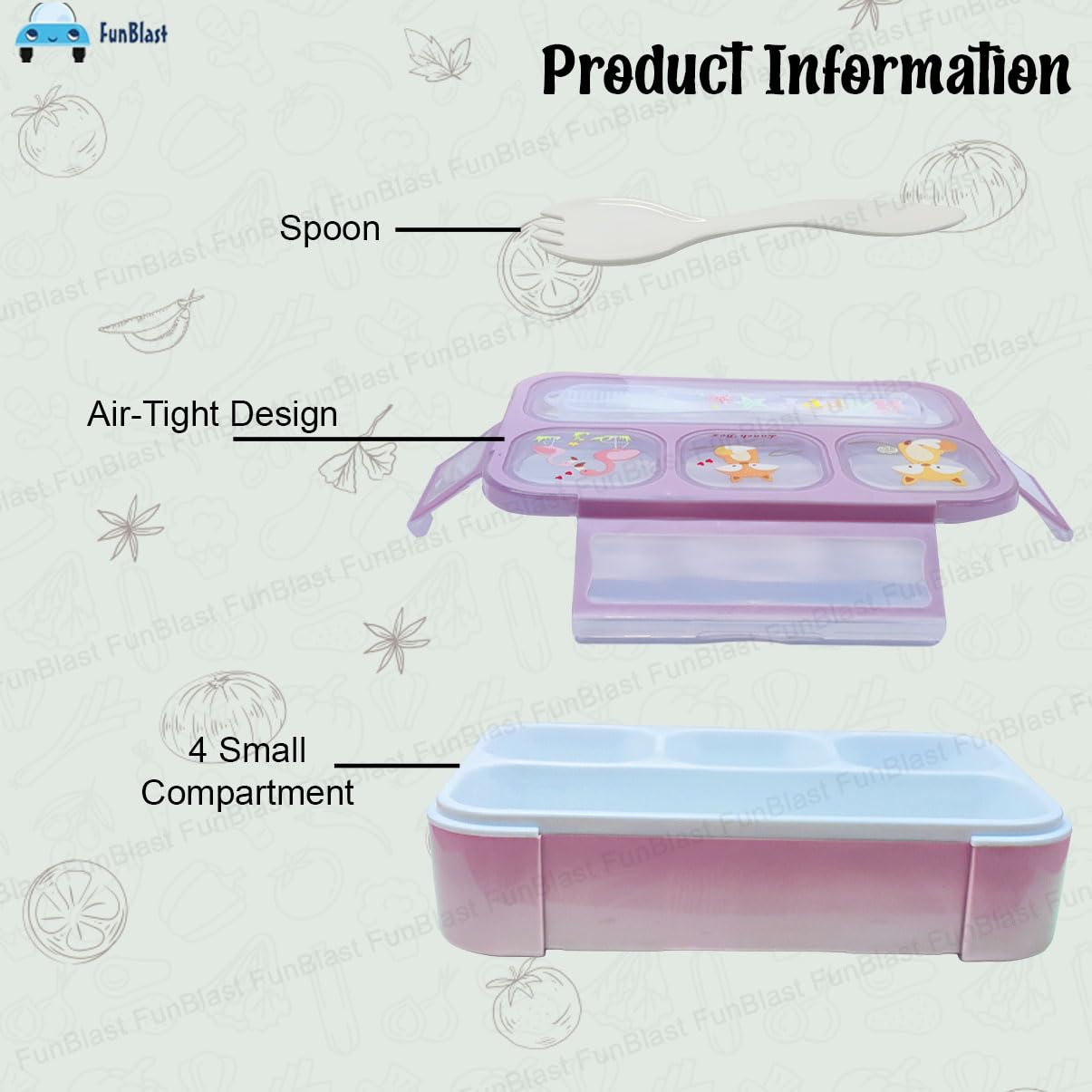
Pink airtight leak-proof lunchbox with four compartments and a spoon, designed for safe school meals
Emergency Response and Medical Care
School staff acted swiftly in this school cardiac arrest emergency. They rushed Prachi to the nearby Danta-Ramgarh Community Health Center. The medical facility was only 500 meters from the school.
Dr. Subhash Verma received the unconscious child at the health center. “She was not breathing and had no pulse,” he reported. The medical team immediately began emergency procedures. They administered CPR, oxygen, and emergency medications for nearly 90 minutes.
Initially, the treatment showed promising results. Prachi responded slightly to the cardiac resuscitation efforts. However, her condition remained critical throughout the emergency treatment.
Furthermore, doctors decided to refer her to SK Hospital in Sikar. The larger facility had better equipment for treating this school cardiac arrest case. Unfortunately, tragedy struck during the transfer process.
Read More : Free Perplexity Pro, Grab for a Year on Airtel
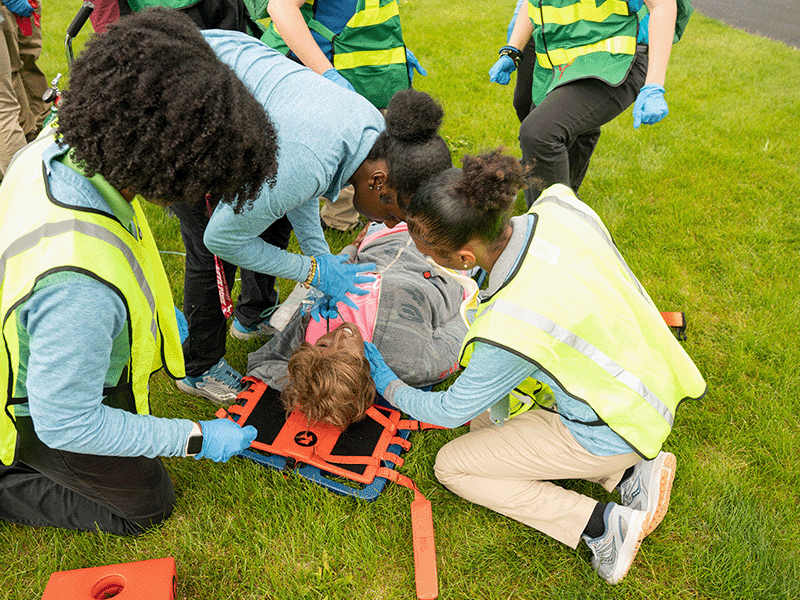
Students practicing emergency medical response on a simulated injured person on grass during training
The Tragic Outcome
While being moved to the ambulance, Prachi suffered another cardiac episode. The ambulance departed the community health center at 12:15 PM. By 1:30 PM, devastating news reached the school staff.
Dr. RK Jangid confirmed the heartbreaking outcome. “She passed away before reaching the hospital,” he stated. The medical team had done everything possible to save her life.
The family chose not to conduct a post-mortem examination. They performed Prachi’s last rites at 4 PM the same day. The entire school community mourned the loss of their bright student.
Read More : iPhone 17 Air Launches September: Ultra-Slim Revolution
Understanding School Cardiac Arrest in Children
Cardiac arrest in children remains extremely rare but devastating when it occurs. Medical experts estimate it affects 1-2 children per 100,000 population annually. Most cases have underlying causes that often go undetected.
Dr. Vittal Kumar Kesireddy explains common triggers for school cardiac arrest incidents. “Undiagnosed heart conditions like congenital defects or genetic disorders,” he notes. These conditions may remain silent until a major event occurs.
Read More : Trump claims jets downed amid India‑Pakistan Operation Sindoor

Infographic on children’s heart health, highlighting obesity risks and tips to maintain a healthy heart through diet and exercise
Primary Causes in Young Children
Congenital heart defects represent the leading cause of sudden cardiac events. These structural abnormalities exist from birth but may not show symptoms. Additionally, genetic conditions like hypertrophic cardiomyopathy can trigger sudden collapse.
Viral infections also play a significant role in pediatric cardiac emergencies. Myocarditis, or heart muscle inflammation, can develop from common viruses. Even mild respiratory infections may sometimes affect heart function.
Moreover, electrical system problems in the heart cause dangerous rhythm disorders. Conditions like Long QT syndrome or Wolff-Parkinson-White syndrome disrupt normal heartbeats. These genetic disorders often remain undiagnosed until emergencies occur.
Read More : Astronomer CEO Caught in Viral Coldplay Moment
Warning Signs Parents Should Watch
Recognizing early symptoms can potentially prevent school cardiac arrest tragedies. Children may experience chest pain during physical activities. However, most chest pain in kids is actually harmless.
Fainting during exercise represents a more serious warning sign. While common fainting from standing up quickly is normal, exercise-related collapse requires immediate medical attention. Parents should never ignore these episodes.
Additionally, unexplained fatigue or breathing difficulties during activities warrant concern. Some children may complain of rapid heartbeats or dizziness. These symptoms deserve proper cardiac evaluation.
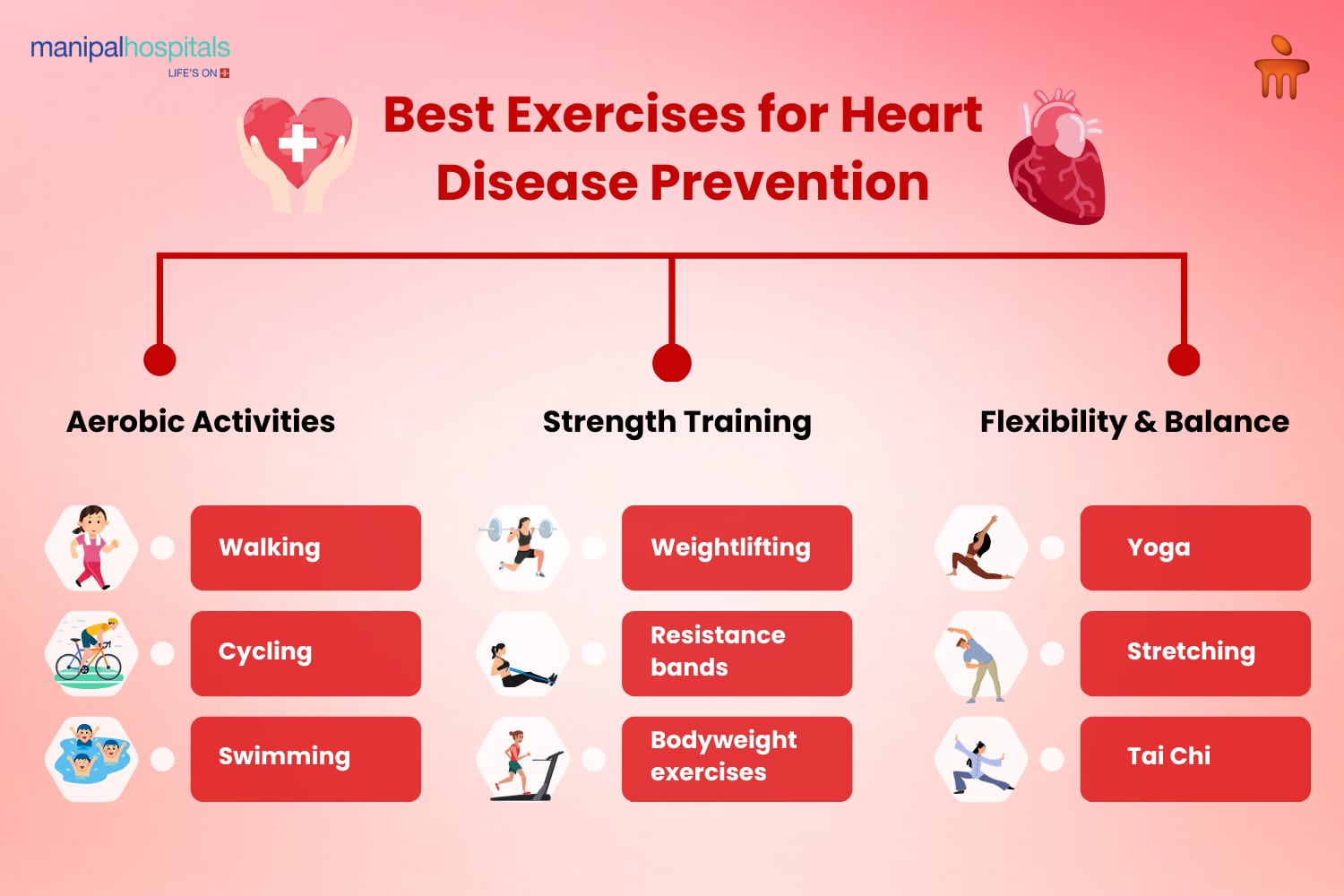
Best exercises for heart disease prevention include walking, cycling, swimming, weightlifting, resistance bands, bodyweight exercises, yoga, stretching, and Tai Chi
School Safety Protocols and Prevention
Educational institutions must implement comprehensive health safety measures. Regular health screenings can identify children at risk for school cardiac arrest events. Schools should maintain updated medical records for all students.
Training staff in emergency response proves crucial for saving lives. CPR certification should be mandatory for teachers and administrators. Quick response can double or triple survival chances in cardiac emergencies.
Furthermore, schools should install automated external defibrillators (AEDs) on campus. These devices can restore normal heart rhythms during cardiac arrest. Proper staff training ensures effective use during emergencies.

Icons illustrating key school health and safety measures including sanitization, health checks, social distancing, and emergency care
Food Safety Guidelines in Schools
The FSSAI has established comprehensive guidelines for school meal safety. These regulations ensure safe food handling and storage practices. Schools must maintain proper hygiene standards in canteens and kitchens.
Temperature control remains critical for preventing foodborne illnesses. Meals should be served immediately after cooking at 65°C. Additionally, ingredients must be stored in appropriate containers with proper labeling.
Regular inspections of food preparation areas help maintain safety standards. Health coordinators should monitor food quality and hygiene practices daily. These measures protect children from potential health hazards.

Colorful divided lunch boxes with healthy foods like rice, vegetables, fruits, and meat illustrate safe and balanced school meals for kids
The Broader Impact on Families
School cardiac arrest incidents devastate entire families and communities. Parents face unimaginable grief when losing a healthy child unexpectedly. The sudden nature of these events makes acceptance extremely difficult.
Prachi’s father works in Gujarat while she lived with family members. The distance made the tragedy even more heartbreaking for the grieving family. They received the devastating news while he was away from home.
School communities also struggle with the emotional aftermath of such incidents. Teachers and students require counseling support after witnessing traumatic events. The psychological impact extends far beyond the immediate family.
Genetic Implications for Surviving Family Members
When children experience cardiac arrest, families face important genetic considerations. Many conditions causing school cardiac arrest run in families. Surviving relatives may need cardiac screening and genetic counseling.
Early detection of inherited heart conditions can prevent future tragedies. Family members should undergo electrocardiograms and echocardiograms as recommended. Genetic testing may also identify specific risk factors.
Additionally, lifestyle modifications can reduce risks for family members. Regular exercise, healthy diet, and avoiding smoking benefit heart health. These preventive measures are especially important for genetically predisposed individuals.
Prevention Strategies and Recommendations
Preventing school cardiac arrest requires comprehensive approaches involving families, schools, and healthcare providers. Regular pediatric checkups can identify potential heart problems early. Sports participation should include thorough cardiac screening.
Parents must stay vigilant about their children’s health complaints. Never dismiss recurring chest pain, fainting, or exercise intolerance. These symptoms warrant immediate medical evaluation by qualified cardiologists.
Moreover, maintaining healthy lifestyles from early childhood reduces future cardiac risks. Balanced nutrition, regular physical activity, and adequate sleep support heart health. Avoiding childhood obesity also prevents later cardiovascular complications.

A healthy and visually appealing school lunchbox with fruits, vegetables, sandwich, and snacks, promoting balanced nutrition for children
Creating Heart-Healthy School Environments
Schools play vital roles in promoting cardiovascular health among students. Physical education programs should encourage age-appropriate exercise activities. However, intense training requires proper medical clearance for participation.
Nutrition education helps students make healthier food choices. School meal programs should emphasize fruits, vegetables, and whole grains. Limiting processed foods and sugary drinks benefits overall health.
Furthermore, stress management techniques support both mental and physical wellbeing. Schools should provide counseling services and stress reduction programs. Emotional health directly impacts cardiovascular function in children.
Medical Advances and Future Prevention
Research continues advancing our understanding of pediatric cardiac conditions. Genetic testing now identifies many inherited heart disorders before symptoms appear. This early detection enables preventive treatments and lifestyle modifications.
Improved school emergency protocols save more lives during school cardiac arrest events. Advanced CPR techniques and rapid defibrillation increase survival rates significantly. Technology also enables faster emergency response coordination.
Additionally, telemedicine allows rapid consultation with cardiac specialists during emergencies. Remote monitoring devices can track heart rhythms in high-risk children. These innovations provide better care access in rural areas.
Links:
Conclusion
The tragic death of nine-year-old Prachi Kumawat serves as a stark reminder of life’s fragility. Her school cardiac arrest incident highlights the urgent need for better pediatric cardiac awareness. While such events remain rare, their impact devastates families and communities.
Prevention requires coordinated efforts from parents, schools, and healthcare providers. Regular health screenings, emergency preparedness, and lifestyle modifications can reduce risks. Most importantly, we must never ignore warning signs in children’s health.
This heartbreaking case should motivate improved safety protocols in educational institutions. Every child deserves a safe learning environment with adequate medical support. Through awareness and action, we can work toward preventing similar tragedies in the future.



